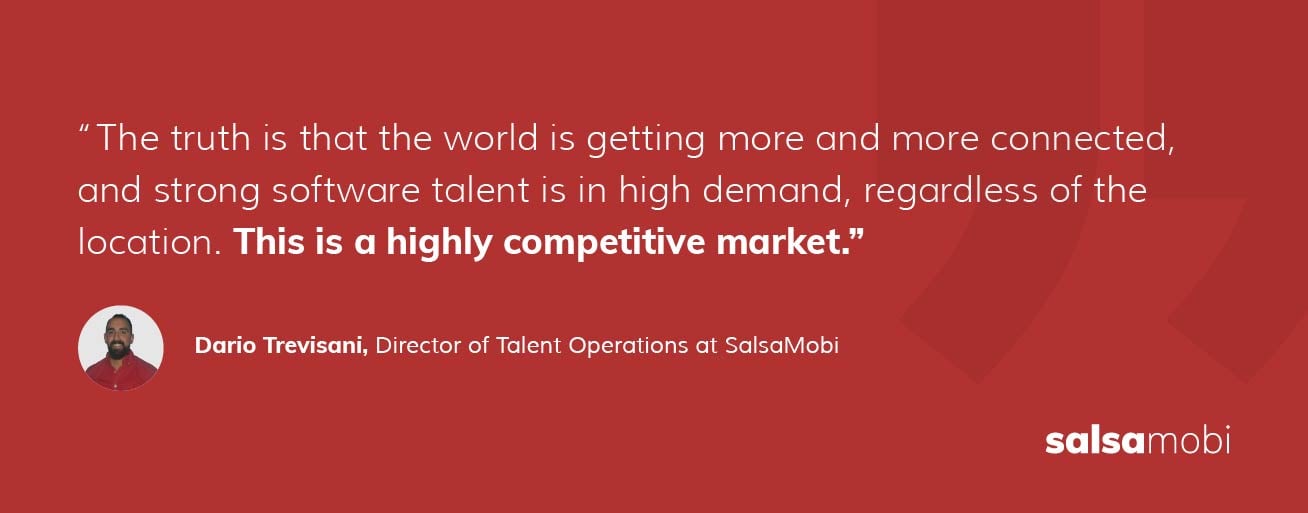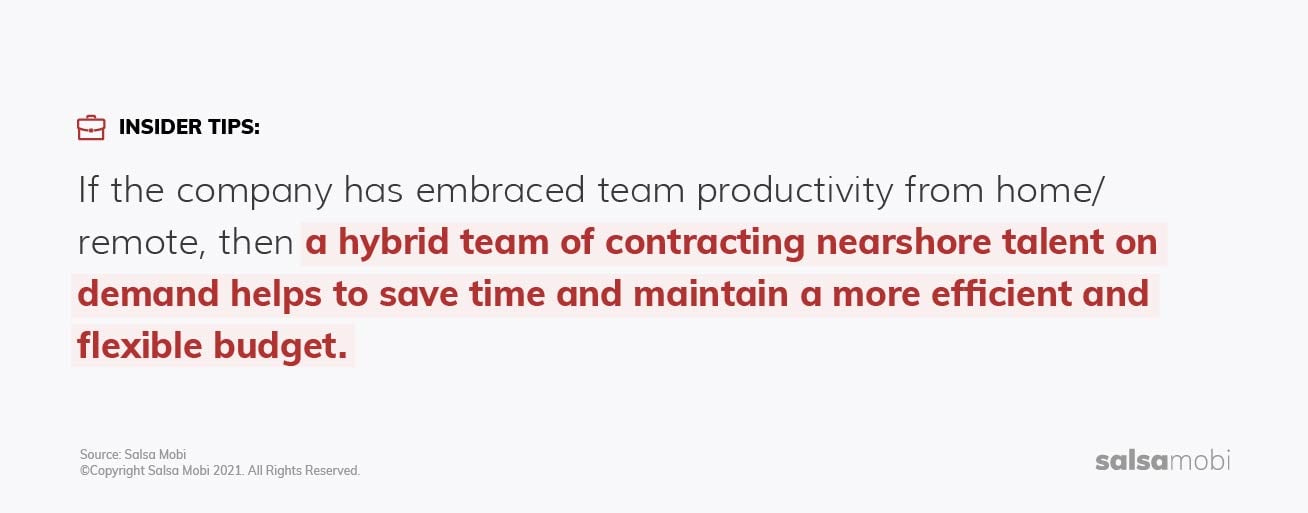- For Employers Hiring Tips
- Sep 07

I’m Dario Trevisani, the Director of Talent Operations at BetterEngineer. I started my recruiting career twelve years ago at a small agency founded by Dimitri Boylan, the former CEO and founder of HotJobs. I was trained on a variety of different recruiting techniques, primarily focused on the IT Industry. Since then, I have worked mainly for software companies, from start-ups to Fortune 500 companies. I am based in Buenos Aires, Argentina, but have worked with companies throughout the world.
One popular way companies are expanding their software development teams is by hiring nearshore talent. In this article, I will address some common misconceptions about this hiring approach and offer guidance on how to organize a remote or hybrid software development team structure.
Why Companies Hire Nearshore Software Engineers
What are some common misconceptions about hiring nearshore talent?
I believe that one of the main misconceptions about hiring nearshore software talent is around contract rates. Companies tend to believe that when using talent from nearshore locations, they will get lower rates than other regions in EMEA or APAC. While this is not always true, hiring nearshore team members is actually more beneficial for other reasons. The time difference is one of the biggest advantages, as it allows both clients and engineers to work on shared schedules.
Some companies are also concerned about finding fluent English speakers and worry that they might need to adapt the way they communicate to the team. Latin America has a very high amount of bilingual talent, reducing language barriers that may exist with offshore teams.
What benefits do companies realize by hiring nearshore engineers?
Another common misconception is the belief that companies are offering a unique type of opportunity to candidates in nearshore regions. The truth is that the world is getting more and more connected, and strong software talent is in high demand, regardless of the location. This is a highly competitive market. Opening up your talent search to qualified candidates in LatAm and beyond means a greater pool of software experts who can contribute to your company’s team.
Nearshore software engineers can be as productive as in-house engineers (sometimes even more so) if given the right level of responsibility and involvement. Distributed teams offer a range of perspectives and problem-solving skills, and are as committed to delivering great results.

How to Organize a Software Team: Remote, Hybrid, or Otherwise
What does a typical software development team structure look like?
While there are many scenarios that different companies use, a popular model we see is a development manager/ScrumMaster who leads 3-5 software engineers, a quality assurance engineer, and a UI/UX designer. Often there is a product owner that has a dotted line to the development manager, and sometimes the designer will report to someone on the product side, rather than the engineering side.
How does a hybrid software development team structure differ?
A hybrid team is often the sweet spot between a costly (and slower-to-hire) fully employed team and a nimble, on-demand, fully outsourced team. This is a model that is proving successful for many modern companies that have embraced a distributed team environment. Typically, the product owner, development manager, and at least one engineer (often a tech lead) will be directly employed by the company. The rest of the team will be integrated/augmented by experienced engineers without current constraints on geography and scarcity. If the company has embraced team productivity from home/remote, then a hybrid team of contracting nearshore talent on demand helps to save time and maintain a more efficient and flexible budget.

How does a fully nearshore software development team structure differ?
Typically, the product owner is a direct employee of the company, and she will outsource to a managed team to do the full design and development. Having a nearshore team allows for more collaborative interaction with all the members of the team, along with integration points to other parts of the organization. Shared or similar time zones facilitate communication and allow processes to be more productive. Many companies have learned to level the culture for all the team members, which often results in augmented talent performing and communicating in a product- and team-oriented way that is on par with the rest of the staff.
How do you screen nearshore engineering talent?
The interview process is very similar to any other “regular” interview process. Nearshore engineers are culturally and technically vetted by our team to confirm their abilities and potential fit with our clients. In many cases, a technical code challenge is required to further evaluate their skill sets. For fully remote work, cultural fit can be as important as technical expertise, so it is important for us to spend enough time with the engineer to understand if they are ready and align with BetterEngineer's values.
Why do companies outsource the recruiting of nearshore engineers?
In many cases, companies turn to nearshore engineers because of a talent shortage. Competition is heated right now and companies cannot afford to hire someone local “just because they are available.” Companies need the right talent to grow and scale, and ideally they realize that it means looking for qualified engineers in other regions.
The cost of an engineer is more competitive in a nearshore market. This is not only because of a lower rate, but also because of the amount of money that companies save by not having to hire directly on their payroll. SalsaMobi takes on all tax responsibilities, as well as payroll and other employer costs. When evaluating whether a nearshore engineer’s rate is high or not, it’s important to consider all the relative information.
Often, companies need engineers for a shorter period of time than a long-term hire, and sometimes a remote team offers a lot more flexibility when trying to hit a tight deadline.
What does a successful onboarding process look like for nearshore engineers?
The main goal here is to make nearshore engineers feel as if they are part of the team. It is usually a bad practice to silo remote engineers apart from the other team members. To get the most productivity from a nearshore engineer, make sure he/she is embedded into the team. Coming from different cultures, nearshore engineers may have new ways of approaching a challenge, and different ways of troubleshooting, so problem solving becomes more rich. Having regular meetings with nearshore team members, especially within the first three months, has proven to be of great help in making them feel welcome and appreciated.
What retention strategies do companies use to keep nearshore talent long term?
There is a lot of value in the flexibility that remote work allows. If the company culture recognizes what is important to remote engineers, it helps to keep them engaged. Software engineers tend to want challenging projects, and feeling that they are on a career path with growth potential is key. When companies truly recognize the contributions that nearshore engineers make to the team (just as with in-house employees), the relationship can flourish over the long term.
Expand Your Software Development Team with Help from BetterEngineer
BetterEngineer connects companies with the right software engineers regardless of location and handles international complexities like completing thorough background checks; ensuring the proper legal, accounting/payroll, and tax compliance documentation is in place; and taking into consideration the labor laws, holidays, and paid-time-off expectations related to a new hire’s country of residence. Contact BetterEngineer for help scaling your team with qualified talent.






